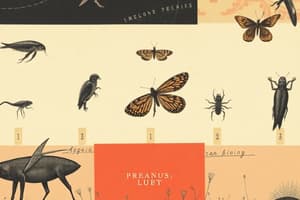Podcast
Questions and Answers
Which characteristic is NOT one of the fundamental traits of living organisms?
Which characteristic is NOT one of the fundamental traits of living organisms?
What type of cell lacks a nucleus?
What type of cell lacks a nucleus?
Which of the following organelles is primarily responsible for ATP production?
Which of the following organelles is primarily responsible for ATP production?
Which domain of life includes organisms without membrane-bound nuclei?
Which domain of life includes organisms without membrane-bound nuclei?
Signup and view all the answers
What distinguishes plant cells from animal cells?
What distinguishes plant cells from animal cells?
Signup and view all the answers
What is one primary difference between autotrophic and heterotrophic nutrition?
What is one primary difference between autotrophic and heterotrophic nutrition?
Signup and view all the answers
What is the significance of the phrase 'Omnis cellula a cellula' in cell theory?
What is the significance of the phrase 'Omnis cellula a cellula' in cell theory?
Signup and view all the answers
Which of the following statements accurately describes the function of ribosomes?
Which of the following statements accurately describes the function of ribosomes?
Signup and view all the answers
What distinguishes prokaryotic cells from eukaryotic cells?
What distinguishes prokaryotic cells from eukaryotic cells?
Signup and view all the answers
How are multicellular organisms characterized in contrast to unicellular organisms?
How are multicellular organisms characterized in contrast to unicellular organisms?
Signup and view all the answers
Study Notes
Biology
- The study of living organisms.
- Life is defined by scientists as a "self-sustaining chemical system," according to NASA.
Characteristics of Living Organisms
- All living organisms exhibit seven key characteristics:
- Reproduction: The ability to create offspring.
- Growth: An increase in size or complexity over time.
- Respiration: The process of using oxygen to release energy from food.
- Nutrition: The intake of nutrients for growth and energy.
- Excretion: Removal of waste products.
- Movement: The ability to change position.
- Sensitivity (responsiveness): The ability to detect and respond to stimuli.
Classification (Taxonomy)
- Living organisms are classified into three domains:
- Archaea: single-celled organisms that thrive in extreme environments.
- Bacteria: single-celled organisms that are diverse and abundant.
- Eukarya: organisms whose cells have a nucleus.
- Within the Eukarya domain, there are five kingdoms:
- Animalia: multicellular organisms that obtain food by eating other organisms.
- Plantae: multicellular organisms that make their own food through photosynthesis.
- Fungi: organisms that absorb nutrients from their surroundings.
- Protista: mostly single-celled organisms that are diverse and often difficult to classify.
- Monera: single-celled organisms that lack a nucleus (prokaryotes).
Cells
- The basic unit of life.
- Every cell originates from another cell (Omnis cellula a cellula).
- Cells contain a membrane, cytoplasm, and genetic material.
- Two types of cells exist:
- Prokaryotic: Lack a nucleus (example: bacteria).
- Eukaryotic: Have a nucleus (example: plants, animals).
- Animal and plant cells share some characteristics:
- Both have a nucleus, membrane, and mitochondria.
- Plant cells have additional features:
- Cell wall: Provides structural support.
- Chloroplasts: Perform photosynthesis.
- Large vacuole: Stores water and other molecules.
- Unicellular organisms, like bacteria and amoeba, consist of one cell.
- Multicellular organisms, like humans and plants, are made up of many cells.
- Nutrition in organisms:
- Autotrophic: Produce their own food through photosynthesis (e.g., plants).
- Heterotrophic: Obtain food by ingesting other organisms (e.g., animals).
Cell Organelles
- Nucleus: Contains DNA, the genetic material of the cell.
- Mitochondria: Sites of energy (ATP) production.
- Ribosomes: Involved in protein synthesis.
- Chloroplasts: Found in plant cells and carry out photosynthesis.
- Cell Membrane: Regulates the entry and exit of substances from the cell.
- Specialized Cells: Different cells perform different functions (division of labor) such as muscle cells and red blood cells.
LUCA
- Last Universal Common Ancestor: The earliest known organism from which all living organisms on Earth are descended.
Biology Definition
- Biology is the study of living organisms.
- Different scientists have varying definitions of life.
- NASA defines life as a "self-sustaining chemical system".
Characteristics of Living Organisms
- Living organisms share common characteristics, often remembered by the acronym RGRNEMS:
- Reproduction: Producing offspring.
- Growth: Increasing in size and complexity.
- Respiration: Obtaining and using energy.
- Nutrition: Obtaining necessary substances for growth and function.
- Excretion: Removing waste products.
- Movement: Changing position or internal movement.
- Sensitivity: Responding to stimuli from the environment.
Classification (Taxonomy)
- Organisms are categorized into Domains and Kingdoms:
- Domains: Archaea, Bacteria, Eukarya.
- Kingdoms: Animalia, Plantae, Fungi, Protista, Monera.
- Organisms are classified based on visible and non-visible characteristics.
- Taxonomists ask questions to classify organisms, such as:
- Does it have a nucleus?
- Can it reproduce?
Cells
- Cells are the basic unit of life.
-
Cell Theory:
- All living organisms are made of cells.
- All cells come from pre-existing cells (Omnis cellula a cellula).
Basic Cell Characteristics
- All cells share basic characteristics:
- Cell membrane: A boundary that controls what enters and exits the cell.
- Cytoplasm: The gel-like substance within the cell.
- Genetic material: DNA (in the nucleus for eukaryotic cells).
Types of Cells
- There are two major types of cells:
- Prokaryotic: Lack a nucleus (e.g., bacteria).
- Eukaryotic: Have a nucleus (e.g., plants, animals).
Animal vs Plant Cells
- Both animal and plant cells have:
- A nucleus.
- A cell membrane.
- Mitochondria (energy production).
- Plant cells have additional structures:
- A cell wall for support.
- Chloroplasts for photosynthesis.
- A large vacuole for storage.
Unicellular vs Multicellular
- Unicellular: Consist of a single cell (e.g., bacteria, amoeba).
- Multicellular: Made up of many cells (e.g., humans, plants).
Nutrition
- Organisms obtain nutrients in different ways:
- Autotrophic: Make their own food through photosynthesis (e.g., plants).
- Heterotrophic: Obtain food by ingesting other organisms (e.g., animals).
Cell Organelles
- Nucleus: Contains DNA, which controls cell function.
- Mitochondria: Responsible for energy (ATP) production.
- Ribosomes: Sites of protein synthesis.
- Chloroplasts: (In plants) Site of photosynthesis.
- Cell Membrane: Controls what enters and exits the cell.
Specialized Cells
- Multicellular organisms have specialized cells that perform specific functions:
- Muscle cells for movement.
- Red blood cells for oxygen transport.
LUCA
- LUCA stands for Last Universal Common Ancestor.
- It is the hypothetical ancestral organism from which all living organisms on Earth descended.
Studying That Suits You
Use AI to generate personalized quizzes and flashcards to suit your learning preferences.
Description
Explore the essential characteristics of living organisms and their classification. This quiz covers concepts such as reproduction, growth, nutrition, and more. Test your knowledge on the domains of life and understand the vast diversity of organisms.




